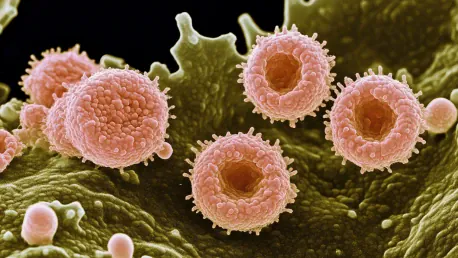A groundbreaking study from Arizona State University (ASU) has discovered remarkable insights about a potentially new healing process prompted by necrosis, the premature death of cells. This unexpected phenomenon, observed in fruit flies known for their regenerative capabilities, may have profound implications for medical science and our understanding of tissue repair. Researchers noted that cells surrounding the necrotic areas send signals promoting growth in healthier tissue parts, which stimulate the production of enzymes called caspases. Traditionally known as executioners in the apoptosis process, caspases exhibit a surprising role in promoting healing when triggered by necrosis over long distances.
New Roles for Caspases
Geneticist Rob Harris from ASU emphasizes the importance of these findings, noting this discovery marks the first evidence that caspases play a significant role in tissue repair following necrosis. This revelation builds on research conducted three years ago, which indicated that necrotic cells could signal unaffected cells located far from the damage site. Optimism surrounds the identification of Necrosis-induced Caspase Positive (NiCP) cells, as they could advance the understanding of tissue regeneration and wound repair mechanisms significantly.
The study findings suggest that only a subset of caspase-enabled cells seem to survive necrosis while playing different roles. Understanding why some cells respond to necrotic events while others do not will be pertinent for future studies to enhance tissue repair mechanisms. According to Chloe Van Hazel, a research technician at ASU, necrotic injuries are known to induce caspase activity even in distant cells, indicating the complexity of this tissue repair mechanism. This discovery highlights a previously unknown aspect of caspase functionality, revealing their potential in regenerative biology and medical treatments.
Implications for Human Medicine
While the study’s results have been primarily observed in fruit flies, this discovery holds significant promise for advancements in human medicine. Researchers hope that understanding and potentially harnessing this process could lead to improved methodologies for human tissue regeneration and wound healing. The study underscores the evolving understanding of caspases’ roles, suggesting that even though humans currently have limited regenerative abilities compared to fruit flies, it might be possible for these mechanisms to be enhanced to better health outcomes as the human body ages.
The findings shed light on an essential genetic response to cell death, potentially paving the way for innovative medical interventions aimed at enhancing tissue repair in necrotic wounds. This significant breakthrough, published in eLife, is a major advancement in the study of tissue repair mechanisms and offers promising prospects for future medical research. The discovery of the alternate role of caspases in tissue repair introduces a paradigm shift, providing researchers with new avenues to explore for therapeutic advancements.
Future Research and Applications
The further study of Necrosis-induced Caspase Positive cells and the mechanisms of caspase activation in response to necrotic injuries remain critical areas of research. Understanding the conditions under which caspases switch from their traditional apoptotic role to a regenerative function could illuminate new strategies for enhancing tissue repair. Researchers plan to delve into why some caspase-activated cells survive necrosis and how these cells contribute to tissue healing, aiming to develop targeted treatments that could replicate or improve this innate capacity.
Medical advancements from this discovery could revolutionize wound care, particularly in chronic or hard-to-heal cases. By uncovering the molecular pathways involved in necrosis-triggered caspase activity, therapies could be developed to enhance the body’s natural repair processes. This line of inquiry represents a promising field of research, potentially leading to significant strides in regenerative medicine.
The study at ASU has opened a new chapter in understanding tissue repair, highlighting the unexpected versatility of caspases. By challenging previously held views about the singular role of caspases in apoptosis, this research paves the way for new therapeutic approaches. Encouragingly, the potential human applications of these findings may offer significant health benefits, making the prospect of improved tissue regeneration a reality.
Transformative Potential
A groundbreaking study from Arizona State University (ASU) has unveiled fascinating insights about a potential new healing mechanism triggered by necrosis, which is the premature death of cells. This unexpected phenomenon was observed in fruit flies, creatures known for their impressive regenerative abilities. The study’s findings could have significant implications for medical science and our understanding of tissue repair processes. Researchers observed that cells neighboring the necrotic regions send out signals that promote growth in the surrounding healthy tissues, leading to the production of enzymes called caspases. Typically, caspases are known as the executioners in the apoptosis process, where they help in programmed cell death. However, when activated by necrosis, caspases take on a surprising role in encouraging healing even over long distances. This discovery opens up new avenues for exploring how necrosis can be harnessed or influenced to improve tissue regeneration and recovery in medical treatments.









